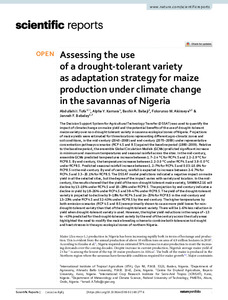| dc.contributor.author | Tofa, A.I. |
| dc.contributor.author | Kamara, A.Y. |
| dc.contributor.author | Babaji, B.A. |
| dc.contributor.author | Akinseye, F.M. |
| dc.contributor.author | Bebeley, J.F. |
| dc.date.accessioned | 2022-09-20T09:25:40Z |
| dc.date.available | 2022-09-20T09:25:40Z |
| dc.date.issued | 2021 |
| dc.identifier.citation | Tofa, A.I., Kamara, A.Y., Babaji, B.A., Akinseye, F.M. & Bebeley, J.F. (2021). Assessing the use of a drought-tolerant variety as adaptation strategy for maize production under climate change in the savannas of Nigeria. Scientific Reports, 11(1): 8983, 1-16. |
| dc.identifier.issn | 2045-2322 |
| dc.identifier.uri | https://hdl.handle.net/20.500.12478/7773 |
| dc.description.abstract | The Decision Support System for Agricultural Technology Transfer (DSSAT) was used to quantify the impact of climate change on maize yield and the potential benefits of the use of drought-tolerant maize variety over non-drought tolerant variety in savanna ecological zones of Nigeria. Projections of maize yields were estimated for three locations representing different agro-climatic zones and soil conditions, in the mid-century (2040–2069) and end-century (2070–2099) under representative concentration pathways scenarios (RCP 4.5 and 8.5) against the baseline period (1980–2009). Relative to the baseline period, the ensemble Global Circulation Models (GCMs) predicted significant increase in minimum and maximum temperatures and seasonal rainfall across the sites. In the mid-century, ensemble GCMs predicted temperatures increase between 1.7–2.4 °C for RCP4.5 and 2.2–2.9 °C for RCP8.5. By end-century, the temperature increases between 2.2–3.0 °C under RCP4.5 and 3.9–5.0 °C under RCP8.5. Predicted seasonal rainfall increase between 1.2–7% for RCP4.5 and 0.03–10.6% for RCP8.5 in the mid-century. By end of century, rainfall is expected to increase between 2–6.7% for RCP4.5 and 3.3–20.1% for RCP8.5. The DSSAT model predictions indicated a negative impact on maize yield in all the selected sites, but the degree of the impact varies with variety and location. In the mid-century, the results showed that the yield of the non–drought tolerant maize variety, SAMMAZ-16 will decline by 13–19% under RCP4.5 and 19–28% under RCP8.5. The projection by end-century indicates a decline in yield by 18–26% under RCP4.5 and 38–47% under RCP8.5. The yield of the drought-tolerant variety is projected to decline by 9–18% for RCP4.5 and 14–25% for RCP8.5 in the mid-century and 13–23% under RCP4.5 and 32–43% under RCP8.5 by the end-century. The higher temperatures by both emission scenarios (RCP 4.5 and 8.5) were primarily shown to cause more yield losses for non-drought-tolerant variety than that of the drought-tolerant variety. There will be 1–6% less reduction in yield when drought-tolerant variety is used. However, the higher yield reductions in the range of − 13 to − 43% predicted for the drought-tolerant variety by the end of the century across the study areas highlighted the need to modify the maize breeding scheme to combine both tolerances to drought and heat stresses in the agro-ecological zones of northern Nigeria. |
| dc.description.sponsorship | Bill & Melinda Gates Foundation |
| dc.format.extent | 1-16 |
| dc.language.iso | en |
| dc.subject | Drought Tolerance |
| dc.subject | Varieties |
| dc.subject | Maize |
| dc.subject | Crop Production |
| dc.subject | Climate Change |
| dc.subject | Nigeria |
| dc.subject | Breeding Programmes |
| dc.subject | Temperature |
| dc.subject | Rainfall Patterns |
| dc.subject | Environment |
| dc.title | Assessing the use of a drought‑tolerant variety as adaptation strategy for maize production under climate change in the savannas of Nigeria |
| dc.type | Journal Article |
| cg.contributor.crp | Maize |
| cg.contributor.affiliation | International Institute of Tropical Agriculture |
| cg.contributor.affiliation | Ahmadu Bello University |
| cg.contributor.affiliation | International Crop Research Institute for the Semi-Arid Tropics |
| cg.coverage.region | Africa |
| cg.coverage.region | West Africa |
| cg.coverage.country | Nigeria |
| cg.coverage.hub | Headquarters and Western Africa Hub |
| cg.researchtheme | Plant Production and Health |
| cg.identifier.bibtexciteid | TOFA:2021 |
| cg.isijournal | ISI Journal |
| cg.authorship.types | CGIAR and developing country institute |
| cg.iitasubject | Agronomy |
| cg.iitasubject | Climate Change |
| cg.iitasubject | Food Security |
| cg.iitasubject | Maize |
| cg.iitasubject | Meteorology and Climatology |
| cg.iitasubject | Natural Resource Management |
| cg.iitasubject | Plant Breeding |
| cg.iitasubject | Plant Production |
| cg.journal | Scientific Reports |
| cg.notes | Published online: 26 Apr 2021 |
| cg.accessibilitystatus | Open Access |
| cg.reviewstatus | Peer Review |
| cg.usagerightslicense | Creative Commons Attribution 4.0 (CC BY 0.0) |
| cg.targetaudience | Scientists |
| cg.identifier.doi | https://dx.doi.org/10.1038/s41598-021-88277-6 |
| cg.iitaauthor.identifier | Alpha Kamara: 0000-0002-1844-2574 |
| cg.futureupdate.required | No |
| cg.identifier.issue | 1 |
| cg.identifier.volume | 11 |
| cg.contributor.acknowledgements | This work was funded by Bill and Melinda Gates Foundation (BMGF) through International Institute of Tropical Agriculture (IITA) under the Project Taking Maize Agronomy to Scale in Africa (TAMASA) with Grant no. OPP1113374. We would also like to thank the Nigerian Meteorological Agency (NIMET) for providing climate data and the staff of Agronomy unit of IITA, Kano office for their support in collecting the experimental data for this research study. |

